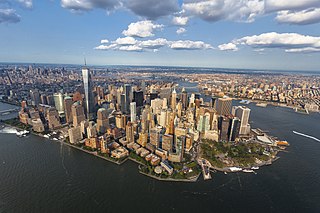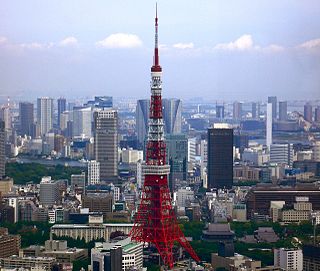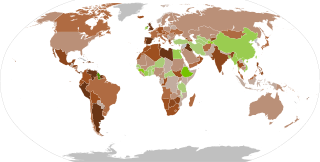Related Research Articles
In economics, a recession is a business cycle contraction that occurs when there is a general decline in economic activity. Recessions generally occur when there is a widespread drop in spending. This may be triggered by various events, such as a financial crisis, an external trade shock, an adverse supply shock, the bursting of an economic bubble, or a large-scale anthropogenic or natural disaster.

The economy of Spain is a highly developed social market economy. It’s the world's 15th largest by nominal GDP and the sixth-largest in Europe. Spain is a member of the European Union and the eurozone, as well as the Organization for Economic Co-operation and Development and the World Trade Organization. In 2021, Spain was the twentieth-largest exporter in the world and the sixteenth-largest importer. Spain is listed 27th in the United Nations Human Development Index and 37th in GDP per capita by the World Bank. Some of the main areas of economic activity are the automotive industry, medical technology, chemicals, shipbuilding, tourism and the textile industry.

The economy of the United Kingdom is a highly developed social market economy. It is the sixth-largest national economy in the world measured by nominal gross domestic product (GDP), Tenth-largest by purchasing power parity (PPP), and twenty-first by nominal GDP per capita, constituting 3.1% of nominal world GDP. The United Kingdom constitutes 2.3% of world GDP by purchasing power parity (PPP).

The United States is a highly developed/advanced mixed economy. It is the world's largest economy by nominal GDP; it is also the second largest by purchasing power parity (PPP), behind China. It has the world's seventh highest per capita GDP (nominal) and the eighth highest per capita GDP (PPP) as of 2022. The U.S. accounted for 25.4% of the global economy in 2022 in nominal terms, and about 15.6% in PPP terms. The U.S. dollar is the currency of record most used in international transactions and is the world's reserve currency, backed by a large U.S. treasuries market, its role as the reference standard for the petrodollar system, and its linked eurodollar. Several countries use it as their official currency and in others it is the de facto currency.

The economy of Venezuela is based primarily on petroleum. Venezuela is the 25th largest producer of oil in the world and the 8th largest member of OPEC. Venezuela also manufactures and exports heavy industry products such as steel, aluminum, and cement. Other notable manufacturing includes electronics and automobiles as well as beverages and foodstuffs. Agriculture in Venezuela accounts for approximately 4.7% of GDP, 7.3% of the labor force and at least one-fourth of Venezuela's land area. Venezuela exports rice, corn, fish, tropical fruit, coffee, pork and beef. Venezuela has an estimated US$14.3 trillion worth of natural resources and is not self-sufficient in most areas of agriculture. Exports accounted for 16.7% of GDP and petroleum products accounted for about 95% of those exports.

In economic policy, austerity is a set of political-economic policies that aim to reduce government budget deficits through spending cuts, tax increases, or a combination of both. There are three primary types of austerity measures: higher taxes to fund spending, raising taxes while cutting spending, and lower taxes and lower government spending. Austerity measures are often used by governments that find it difficult to borrow or meet their existing obligations to pay back loans. The measures are meant to reduce the budget deficit by bringing government revenues closer to expenditures. Proponents of these measures state that this reduces the amount of borrowing required and may also demonstrate a government's fiscal discipline to creditors and credit rating agencies and make borrowing easier and cheaper as a result.
The early 1990s recession describes the period of economic downturn affecting much of the Western world in the early 1990s. The impacts of the recession contributed in part to the 1992 U.S. presidential election victory of Bill Clinton over incumbent president George H. W. Bush. The recession also included the resignation of Canadian prime minister Brian Mulroney, the reduction of active companies by 15% and unemployment up to nearly 20% in Finland, civil disturbances in the United Kingdom and the growth of discount stores in the United States and beyond.

The early 1980s recession was a severe economic recession that affected much of the world between approximately the start of 1980 and 1982. It is widely considered to have been the most severe recession since World War II until the 2007–2008 financial crisis.

The Great Recession was a period of marked general decline observed in national economies globally, i.e. a recession, that occurred in the late 2000s. The scale and timing of the recession varied from country to country. At the time, the International Monetary Fund (IMF) concluded that it was the most severe economic and financial meltdown since the Great Depression. One result was a serious disruption of normal international relations.
This article gives the timeline of the Great Recession, which hit many developed economies in the wake of the financial crisis of 2007-2008.
The European recession is part of the Great Recession that began in mid-2007. The crisis spread rapidly and affected much of the region, with several countries already in recession as of February 2009, and most others suffering marked economic setbacks. The global recession was first seen in Europe, as Ireland was the first country to fall into recession from Q2-Q3 2007 – followed by temporary growth in Q4 2007 – and then a two-year-long recession.
While beginning in the United States, the Great Recession spread to Asia rapidly and has affected much of the region.

The Lost Decades is a lengthy period of economic stagnation in Japan precipitated by the asset price bubble's collapse beginning in 1990. The singular term Lost Decade originally referred to the 1990s, but the 2000s and the 2010s have been included by commentators as the phenomenon continued.

In economics, stimulus refers to attempts to use monetary policy or fiscal policy to stimulate the economy. Stimulus can also refer to monetary policies such as lowering interest rates and quantitative easing.
Recession shapes or recovery shapes are used by economists to describe different types of recessions and their subsequent recoveries. There is no specific academic theory or classification system for recession shapes; rather the terminology is used as an informal shorthand to characterize recessions and their recoveries. The most commonly used terms are V-shaped, U-shaped, W-shaped, and L-shaped recessions, with the COVID-19 pandemic leading to the K-shaped recession. The names derive from the shape the economic data – particularly GDP – takes during the recession and recovery.

The 1973–1975 recession or 1970s recession was a period of economic stagnation in much of the Western world during the 1970s, putting an end to the overall post–World War II economic expansion. It differed from many previous recessions by involving stagflation, in which high unemployment and high inflation existed simultaneously.
In the United States, the Great Recession was a severe financial crisis combined with a deep recession. While the recession officially lasted from December 2007 to June 2009, it took many years for the economy to recover to pre-crisis levels of employment and output. This slow recovery was due in part to households and financial institutions paying off debts accumulated in the years preceding the crisis along with restrained government spending following initial stimulus efforts. It followed the bursting of the housing bubble, the housing market correction and subprime mortgage crisis.

The United Kingdom national debt is the total quantity of money borrowed by the Government of the United Kingdom at any time through the issue of securities by the British Treasury and other government agencies.

Abenomics refers to the economic policies implemented by the Government of Japan led by the Liberal Democratic Party (LDP) since the December 2012 general election. They are named after Shinzō Abe (1954–2022), who had been appointed as Prime Minister of Japan on his second term from 2012 to 2020. Abe was the longest-serving prime minister in Japanese history. After Abe resigned in September 2020, his successor, Yoshihide Suga, stated that his premiership would focus on continuing the policies and goals of the Abe administration, including the Abenomics suite of economic policies.

The COVID-19 recession, also known as the Great Lockdown, was a global economic recession caused by the COVID-19 pandemic. The recession began in most countries in February 2020. After a year of global economic slowdown that saw stagnation of economic growth and consumer activity, the COVID-19 lockdowns and other precautions taken in early 2020 drove the global economy into crisis. Within seven months, every advanced economy had fallen to recession.
References
- ↑ "Q&A: What is a recession?". BBC News. 8 July 2008.
- ↑ "Glossary of Treasury terms". HM Treasury. Archived from the original on 2 November 2012. Retrieved 25 October 2012.
- 1 2 Inman, Phillip (7 May 2020). "War and the weather: what caused the huge economic slump of 1706?". The Guardian. ISSN 0261-3077 . Retrieved 2 July 2020.
- ↑ "What happened in 1709? Why the UK economy slumped into a recession". inews.co.uk. 15 April 2020. Retrieved 15 May 2020.
- ↑ "Public Spending Chart for United Kingdom 1800–1830 – Central Government Local Authorities". ukpublicspending.co.uk. Retrieved 9 August 2016.
- 1 2 3 4 "Public Spending Chart for United Kingdom 1800–1900 – Central Government Local Authorities". ukpublicspending.co.uk. Retrieved 9 August 2016.
- 1 2 Cain, P. J.; Hopkins, A. G. (2002). British Imperialism, 1688–2000. Longman. ISBN 9780582472860 . Retrieved 9 August 2016.
- ↑ "Public Spending Chart for United Kingdom 1856–1859 – Central Government Local Authorities". ukpublicspending.co.uk. Retrieved 9 August 2016.
- ↑ "Public Spending Chart for United Kingdom 1865–1868 – Central Government Local Authorities". ukpublicspending.co.uk. Retrieved 9 August 2016.
- 1 2 D Smith, Sunday Times (UK) 9 November 2008
- ↑ "NIESR graph of 6 UK recessions" (PDF).
- 1 2 3 4 "Bank of England February 2009 Quarterly inflation report" (PDF). Bank of England. Archived from the original (PDF) on 15 November 2009. Retrieved 9 August 2016.
- 1 2 "Economy tracker: GDP". BBC News. 27 January 2015. Retrieved 9 August 2016.
- 1 2 3 4 5 6 7 "Quarterly National Accounts – National accounts aggregates (ABMI Gross Domestic Product: chained volume measures: Seasonally adjusted £m, constant prices)". Office for National Statistics. 20 December 2013.
- ↑ "Economic policy and the motor recession". The Spectator. 12 July 1956. Retrieved 9 August 2016.
- ↑ Love 1969, p. 651
- ↑ "A Review Of Past Recessions | Investopedia". investopedia.com. Retrieved 9 August 2016.
- 1 2 "UK unemployment". Financial Tubes, 20 November 2008
- ↑ "CBI February 2009 Economic forecast" (PDF). Confederation of British Industry. Archived from the original (PDF) on 27 September 2011. Retrieved 9 August 2016.
- ↑ "UK GDP since 1955 | Business Rogers". The Guardian. 9 March 2009. Retrieved 9 August 2016.
- ↑ Partington, Richard (12 February 2021). "UK economy hit by record slump in 2020 but double-dip recession avoided". The Guardian.
- 1 2 "The inflationary consequences of real shocks".
- ↑ Wallace, Tim; Chan, Szu Ping (15 February 2024). "How worklessness and school truancy drove Britain into recession". The Telegraph. Archived from the original on 15 February 2024.
- ↑ "UK falls into recession, and a far deeper living standards downturn • Resolution Foundation". 15 February 2024.
- ↑ "Migration too high says Sunak, as total hits record level". BBC News. 25 May 2023.